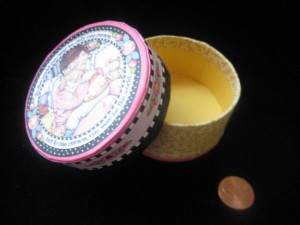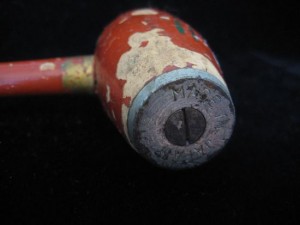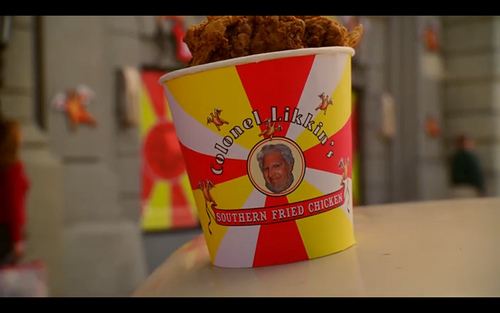 CROSSOVER POP
CROSSOVER POP
One of the longest-running — and weirdest — unsolicited celebrity endorsements
Insane Clown Posse mention Faygo a lot and spray concertgoers with it during shows. This has resulted in one of the longest-running instances of an unsolicited celebrity endorsement.
Read the column in the August 29, 2010, New York Times Magazine, or here.
Discuss, make fun of, or praise this column to the skies at the Consumed Facebook page.
Posted Under:
Consumed,
Entertainment
This post was written by Rob Walker on August 28, 2010
Comments Off on In The New York Times Magazine: Involuntary branding
No Consumed today, but I have a feature on ROFLCulture, here.
[Big] thinkers [are] engaged in the popular debate over whether the Internet makes us smarter or dumber. And that question is interesting, but let’s face it: it’s not awesome. What Tim Hwang and his cohorts basically hit upon was the conclusion that, while that debate drags on, funny cat pictures and so on are really, really popular. And maybe another question to consider is what that means — to consider the Web not in terms of how it might affect who we become but rather in terms of how it reflects who we are. ROFL, after all, is not a seductive theory about what enlightened things democratized culture may one day produce; it is a pervasive fact on the ground. This is how sizable chunks of our cognitive resources are actually being deployed, so it’s worth trying to figure out why that is, what functions this stuff serves and how it differs from or falls in line with more familiar forms of entertainment. Perhaps, in other words, it’s worth taking ROFL seriously. Or at least sort of seriously.
Posted Under:
America,
Entertainment,
ROFLculture
This post was written by Rob Walker on July 18, 2010
Comments Off on In The New York Times Magazine: Taking ROFL (Sort of) Seriously
For obvious reasons the discussion of the idea of books has focused quite heavily on the e-variety these last few days, as speculation abounds over The Meaning of the iPad For The Printed Word.
The Telegraph reports on a book that will have a sort of instant sequel “assembled from the best comments by readers of” the author’s Website. A publishing type who is involved comments:
With devices like the iPad nearly at our shores and more routes for communication than ever before, I believe that especially in non-fiction, the distance between the author and reader should start to disappear. Authors will become more like curators and take influence from their readers’ suggestions during and after they have written their work.
Meanwhile, Nicholas Carr suggests that what we’re headed for is books becoming multimedia apps, in a sort of post-reader world. He quotes some other publishing-world guy:
“The definition of the book itself seems up for grabs,” he said at a recent media industry powwow. Unlike traditional e-book readers, which had a rather old-fashioned attachment to linear text, the iPad opens the doors to incorporating all sorts of “cool stuff,” Makinson continued. “We will be embedding audio, video and streaming into everything we do.” He foresees sprinkling movie clips among Jane Austen’s paragraphs in future editions of “Pride and Prejudice.”
Hm. What do you think?
Perhaps I’ll “curate” the best of your responses into a follow-up post!
With video?
 We were interested here at Murketing HQ when it came to our attention not long ago that James Franco, a pretty successful movie actor, was doing a stint on General Hospital. The story went that this is something he wanted to do, although it wasn’t clear to us why. Fan of the show? Curious about it as an acting experiment? Unpaid gambling debts? Hard to say. In any case he’s taken on the role of an artist — and villian — named Franco. While we did not have a firm explanation for all this, I think it’s safe to say we applauded it.
We were interested here at Murketing HQ when it came to our attention not long ago that James Franco, a pretty successful movie actor, was doing a stint on General Hospital. The story went that this is something he wanted to do, although it wasn’t clear to us why. Fan of the show? Curious about it as an acting experiment? Unpaid gambling debts? Hard to say. In any case he’s taken on the role of an artist — and villian — named Franco. While we did not have a firm explanation for all this, I think it’s safe to say we applauded it.
Today’s WSJ has an essay by James Franco, that sort of discusses his GH turn, and explains it as performance art. Actually the essay is mostly about performance art, and you can read that here if you like. Here’s all he he has to say about his soap role:
I finally took the plunge [into performance art] and experimented with the form myself when I signed on to appear on 20 episodes of “General Hospital” as the bad-boy artist “Franco, just Franco.” I disrupted the audience’s suspension of disbelief, because no matter how far I got into the character, I was going to be perceived as something that doesn’t belong to the incredibly stylized world of soap operas. Everyone watching would see an actor they recognized, a real person in a made-up world. In performance art, the outcome is uncertain—and this was no exception. My hope was for people to ask themselves if soap operas are really that far from entertainment that is considered critically legitimate. Whether they did was out of my hands.
Hm. Well, I’m not sure I agree with all of that, but I see what he’s saying. He goes on to discuss performance art and his interest in it, and doesn’t return to the GH experience until the end.
The folks at “General Hospital” informed me that in three days of filming we backlogged enough material for 23 episodes. There will be one more step. After all of the Franco episodes are aired, my character’s storyline will be advanced in a special episode filmed in a “legitimate” New York gallery. One more layer will be added to this already layer-heavy experiment. If all goes according to plan, it will definitely be weird. But is it art?
I’m not sure how I feel about the gallery angle, and I don’t really care if it’s “art” or not. But by and large this is all pretty interesting. The author tag on the story says that Franco “is currently enrolled in NYU’s MFA filmmaking program and Columbia’s MFA program for fiction writing.”
I wish I knew somebody who knows this guy. I’d invite him to write for Significant Objects. He could do so as “Franco,” if he liked.
 REALITY BYTES
REALITY BYTES
Does ‘augmented reality’ technology help us see deeper into what’s before our eyes?
This phrase has become one of the pervasive buzz concepts of 2009, and as is often true in such cases, it seems to describe a variety of manifestations from the practical to the pointless to the pie in the sky….
Read the column in the November 15, 2009, New York Times Magazine — a special entertainment-focused issue — or here.
Discuss, make fun of, or praise this column to the skies at the Consumed Facebook page.
Posted Under:
Consumed,
Entertainment
This post was written by Rob Walker on November 14, 2009
Comments Off on In The New York Times Magazine: Augmented Reality

Early on in Significant Objects, someone commenting on a BoingBoing post about the project opined:
I hate to tell you this, but you’ve basically just reinvented advertising. Good advertising takes a product and imbues it with some kind of story. The only differences are that 1) generally speaking the product is new instead of used, 2) the story is usually less specific to any individual and more generally applicable to the mass-produced nature of the product and 3) the artifice in the story is more or less deliberately concealed.
Another comment-er, noting those rather extensive and far-reaching “only differences,” replied: “Oh, is that all? LOL. Anyway, perhaps both advertising and the Significant Objects project are stories, because everything is a story.”
It’s a fair point that the difference between the way we bring Significant Objects readers “in on” what we’re doing is distinct from artifice that is “deliberately concealed.” On the other hand, a Chicago Tribune article about the project explored the parallels between Significant Objects and advertising in a more thoughtful way, citing examples that fall on a continuum of disclosure and artifice, from McDonaldland characters to the J. Peterman catalog to high end grocers putting out “little cards at the foot of produce that explain how the farmer who harvested this broccolini owns seven chickens and drives his daughter to school in a biodiesel-fueled pickup truck every morning.” (The Tribune piece is here.)
In the past I’ve defined branding as the process of attaching an idea to a product. There’s not too much logic-torture involved to say that this puts me in the camp that does see some connection between storytelling and advertising. Although I guess I would say that in addition to the advertising’s shortcomings on the honesty front, branders tend to tell nonlinear, abstract stories, as opposed to straight narratives. Especially in recent years.
Long ago, advertising might mean a page of a magazine with a big hunk of text (that often read quite a bit like a short story). Nowadays a brand like Axe, or Burger King, tells its “story” in what Henry Jenkins calls a “transmedia” manner: Across multiple platforms, in ways that might sense however you encounter them, but that are simultaneously cumulative. In fact I think marketers are way ahead of the entertainment industry (Jenkins’ focus) in transmedia storytelling, even if the branding version of it basically shrugs off linearity. The Dove Campaign For Real Beauty, for instance, posits a line of facial creams and whatnot as embodying a set of ideas about the nature of beauty itself, expressed via billboards and commercials, but also via text-message voting schemes, media appearances by its participating models, at least one stage play, and other murketing tactics. The “story” has no beginning, and no end. (It will probably stop at some point, but there will be no finale.) But there’s always a story of some kind — and in fact I’ll but the story always fits the Totem, Talisman, Evidence, and/or Fossil categories that my Significant Objects partner Joshua Glenn has defined.
The way our writers have approached stories has certainly varied. Daily Show writer Tim Carvell’s Round Box story is very much a narrative (albeit one with surprises). Bee Season/Wicket’s Remedy author Myla Goldberg’s approach to giving Significance to a Hand Held Bubble Blower is not. Nor is David Shield’s remarkable Military Figure piece. And those are just recent examples.
It would actually be rather exciting to tell the “story” of one of our Significant Objects in a truly transmedia manner. Our writers don’t have quite the budget that Unilever provides its various agencies to tell the story of Dove stuff. One of our contributors, Colson Whitehead, did surprise us by extending the story of his object into his Twitter stream; his Tweets not only amplified what he’d written, but broke the “fourth wall” (as they used to say mass-com classes, and for all I know still do) with Tweets purportedly about the motives of bidders.
It was great storytelling, and at least a little bit transmedia. And, yes, it was almost certainly an effective strategy in boosting the auction for Whitehead’s Significant Object. The wooden mallet that he wrote about, which was bought for 33 cents at a yard sale, sold for $71.

At this point I think the only interesting thing about Mad Men (to me) is the disconnect between the amount of attention it gets from the media and marketing crowd, and the number of people who actually watch it.
Did you know, to cite a random example, that a recent rerun of Two And A Half Men got nearly triple the audience of the Mad Men season premiere (which apparently was the latter show’s largest audience ever)?
If you missed it, I really recommend Michael Pollan’s cover story from the Times Mag this weekend, on food preparation as something we watch on television, rather than something we do. It’s really well done. Here’s one side note that’s particularly relevant to this site:
It’s no accident that Julia Child appeared on public television — or educational television, as it used to be called. On a commercial network, a program that actually inspired viewers to get off the couch and spend an hour cooking a meal would be a commercial disaster, for it would mean they were turning off the television to do something else. The ads on the Food Network, at least in prime time, strongly suggest its viewers do no such thing: the food-related ads hardly ever hawk kitchen appliances or ingredients (unless you count A.1. steak sauce) but rather push the usual supermarket cart of edible foodlike substances, including Manwich sloppy joe in a can, Special K protein shakes and Ore-Ida frozen French fries, along with fast-casual eateries like Olive Garden and Red Lobster.
Yes. And of course those advertisers know exactly what they are doing: Associating their processed or prepared-for-you foodstuffs and meals with the vague idea of hands-on cooking. Maybe watching someone expertly prepare a meal from scratch is something that makes you feel good, and if a can of Manwhich can associate itself with that good feeling, nonconsciously of course, perhaps that association will still lurk in your brain somewhere as you wheel through Kroger.
The whole piece is actually full of great stuff about consumer behavior, advertising, and entertainment, filtered through the lens of food. Great stuff.
Earlier today I saw, on a blog, a reference to a trailer for a documentary I hadn’t heard of but that sounded interesting. I clicked and went to a site called MovieWeb.com.
Before the trailer started, there was an ad (for Axe hair gel). When the trailer started, text ads popped up on the bottom of the video window, advertising other movie-trailer sites I might want to check out. And of course above the video window there was a banner ad, for a movie, and to the right another ad (for Axe).
That seems like an awful lot of sponsorship to deal with … just to watch what is, after all, an ad for a movie.

As some of you know, I have (https://comfortdentalcareofbrookline.com/order-zithromax-500mg-online/) a particular fascination with imaginary brands — it’s a subject that’s come up in Consumed (here and here), and on this site, and in my Delicious links. So I was extremely interested to learn of this Tumblr blog, curated by Gladys Santiago, documenting what she calls “product displacement.”
This involves the use of imaginary brands as, in effect, stand-ins for real brands we already know. For instance, above, a bucket of Colonel Likkin’s Southern Fried Chicken. I don’t have to tell you what that stands in for. Apparently it was used on the TV show Pushing Daisies. Other examples: Coffee Bucks on Scrubs, and TitTat candy on My Name Is Earl. (The Product Displacement blog also documents instances of unbranding — as when the logos are removed from cars and so on — but I’m not going to address that here.)
Santiago (who I got to meet, briefly, the other night at the Blowing Up The Brand event) explains the parameters of product displacement here. And here she argues that some product displacements are “arguably more clever and memorable than even some of the most exhaustedly planned brand integration strategies. ”
It requires no stretch of the imagination to recognize “Tit Tat” and “Coffee Bucks” as stand-ins for real brands, but that recognition allows audiences to engage with product placements in a manner that is significantly more encompassing than simply spotting a branded product onscreen. Referencing these product displacements to their real world counterparts requires audiences to actively draw upon their cultural capital and awareness, therefore they have more resonance than a strategically placed can of Coca-Cola or character mindlessly raving about his/her T-Mobile phone.
Ultimately, product displacements have the opportunity to flatter the intelligence of viewers, especially if they are parodic and satirical in nature. I particularly like My Name is Earl and Scrubs examples because they provide an allure of audience members being in on a private joke that mocks Kit Kat and Starbucks.
Pretty interesting!
Oh, and Santiago has also created this massive Flickr set of “deliberate and unintentional” examples of product appearances in scripted shows.
UPDATE: Follow-up posts worth a look on Eyecube, and AdFreak.
Posted Under:
Entertainment,
Imaginary Brands
This post was written by Rob Walker on May 12, 2009
Comments Off on Imaginary brands as “product displacement”
In this item about the (to me) creepy-sounding possibility of monitoring what your friends are watching on YouTube, while they monitor you back, I was surprised by this assertion:
Many people go to YouTube without any particular video in mind — they simply go to watch something.
Really? Do you do that?
I’m pretty sure I only go to YouTube with a video in mind, or by way of a link to a specific video that’s been brought to my attention in some way or other.
I don’t know.
But Carl Wilson does, and posted something about his experience that I found really illuminating as a regular watcher of the show:
The show did a pre-interview with me by phone the day before and I almost wish that one could have been televised instead: The producer started by saying that she was going to ask me a bunch of serious questions, “which tomorrow will be turned into jokes — but answer them then the same way you answer me now,” and proceeded to ask some of the most intelligent, well-thought-out questions I’ve had from any interviewer…
Fascinating. The whole post is pretty interesting, actually.
But what’s really great is Carl’s book, Let’s Talk About Love: A Journey To The End of Taste.
Yes, Carl is a friend from the old days, but disregard any potential bias and just trust me.
According to Brandweek:
“There’s a financial cry in the country right now — and that’s going to translate into shopping,” says Karen Bard, the resident pop-culture expert for online auction site eBay. Bard’s not talking about how much people are spending so much as what they’re buying. Sales of just about anything related to the Great Depression have been surging since Christmas. In the last three months, eBay’s category “Depression Era” has seen a 15 percent increase in sales traffic, with specific spikes recorded for 1930s music (up 8 percent) and cloche hats (up 65 percent). At Amazon, December 2008 sales of Depression-related titles (including The Great Crash, The Forgotten Man and Ben Bernanke’s Essays on the Great Depression) were up by a whopping 750 percent (the company does not disclose unit sales).
Depression momentum started building just before the holiday shopping rush-which was, not coincidentally, the same time that bad news about the economy began to feel merely like harbingers of far worse. Between September and October, Netflix recorded a 10 percent rise in rentals of The Grapes of Wrath.
The other day I read something in The New Republic, a book review in which the writer said in passing: “The media industry’s attacks on the net can be scary, but they can also be understood as death throes.”
I had to read that sentence again. What was he talking about? Not the death throes — I get that part. The scary attacks. I realized he must be referring to the occasional high-minded broadsides about blogs dumbing down the culture, or whatever. I’ve seen those. But does anybody really find them “scary”? Surely nobody in the new-media blogosphere does. Such laments have approximately zero impact, and are routinely swatted down by the blognoscenti as, yes, the death throes of irrelevant gatekeeper dinosaurs who don’t get it and don’t matter anymore. “Dead tree media” and all that.
The next day I was skimming an issue of New York Magazine and noticed this exchange in a Q&A with Rob Corddry about his new Web-only show, Children’s Hospital.
Q: How do you market a Web show?
A: I had my publicist get me an interview at New York Magazine.
Q: Seriously.
Corddry goes on to say something vague about “manipulating Google,” but the right answer is: “Um, seriously. Who the fuck are you kidding? Mainstream media eats up news of the latest new-media whatever with a spoon!”
After all, isn’t that the case? Occasional broadsides notwithstanding, hasn’t the traditional media, by and large, functioned largely as a cheerleader for and amplifier of new media? If Corddry has a traditional sitcom, nobody (in the mainstream media) really cares. But he has a Web-based sitcom? Oooh! Cutting-edge! Write it up!
The Times Magazine (my primary client, of course) has done more than one cover story about bloggers, and has hired one of the most talented critics I’ve ever met to do a column about aspects of Web-media culture every week. The column is not a series of scary attacks. Meanwhile, every section of the paper has done multiple stories about this or that blogger in almost every category imaginable — design, gossip, restaurants, politics, “citizen journalists,” whatever. I would certainly guess the paper has run more stories about Twitter than about, say, a TV show like N.C.I.S., which probably has at least double the audience.
But this makes sense, in that the new-media stories are, you know, newer. More like news. Indeed I would actually say that one meta-story that the traditional media has covered quite thoroughly in the last 10 or 15 years is the story of the new media. Has there ever been a significant online phenomenon that was not only covered but in effect abetted by mainstream coverage? That is to say: I wonder how often new-media properties, from Napster to Facebook, take off precisely because old media introduced them to a wider audience. Or at the very least, if the old-media coverage didn’t juice things along much faster than might have otherwise occurred.
I’m not suggesting that new-media forms wouldn’t catch on anyway. But I am suggesting that the number of “scary attacks” from the old media are far outweighed by “ya gotta check this out” hype. Which is exactly why Corrdry’s new-media strategy involved having his publicist call New York Magazine.
 A story in the WSJ yesterday explained that Unilever’s famous “Campaign For Real Beauty” for its Dove products wasn’t working in China, where “women aren’t so bothered by the stunning models used in most beauty ads and aren’t driven to buy products promoted with so-called real faces.” Apparently the multinational has found what it hopes is a solution, by way of “Ugly Betty.” No, they aren’t simply sponsoring the Chinese version of the show — they’ve worked out a deal to basically produce a Chinese version of the show:
A story in the WSJ yesterday explained that Unilever’s famous “Campaign For Real Beauty” for its Dove products wasn’t working in China, where “women aren’t so bothered by the stunning models used in most beauty ads and aren’t driven to buy products promoted with so-called real faces.” Apparently the multinational has found what it hopes is a solution, by way of “Ugly Betty.” No, they aren’t simply sponsoring the Chinese version of the show — they’ve worked out a deal to basically produce a Chinese version of the show:
In an unusual move, Unilever’s ad-time-buying agency, WPP Group PLC’s Mindshare, brokered a deal to bring the format to Chinese TV, giving Unilever the right to exclusive ads and product placements during the show, as well as a script built around the company’s Chinese reformulation of the campaign for real beauty. …
On “Ugly Wudi,” protagonist Lin Wudi, who works at an ad agency, learns to unveil her own beauty, using Dove products and working on an imaginary ad campaign for the brand. …
In one episode, an actor playing the media director for Dove in China explains that an ad campaign that Wudi helped create epitomizes Dove’s view on beauty. “There are so many kinds of women and so many kinds of beauty,” he says. “This is exactly the message that Dove tries to put forth.”
 CROSSOVER POP
CROSSOVER POP



 "
"

















 Kim Fellner's book
Kim Fellner's book  A
A